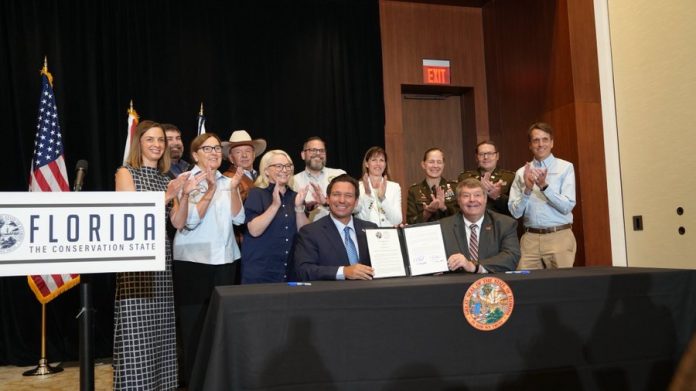Florida Construction News staff writer
The State of Florida and the U.S. Department of the Army have finalized a landmark agreement that will allow the state to take the lead on major portions of the Comprehensive Everglades Restoration Plan (CERP), including the Everglades Agricultural Area (EAA) Reservoir — described by officials as the “crown jewel” of Everglades restoration.
Governor Ron DeSantis called the agreement a major victory for environmental restoration and water management in Florida.
“A long-awaited project, first envisioned and authorized decades ago, is finally becoming a reality,” DeSantis said in a statement. “The EAA Reservoir is not only fully funded and under construction — it’s moving forward faster than expected, thanks to new state and federal cooperation.”
Located south of Lake Okeechobee, the EAA Reservoir will store more than 78 billion gallons of water and is expected to deliver up to 470 billion gallons of clean water annually to the Everglades and Florida Bay. The project also supports the Biscayne Aquifer, the primary drinking water source for millions of South Floridians.
The new agreement will shift significant responsibilities to the state, allowing Florida to manage construction of the reservoir’s inflow and outflow pump stations, as well as the Blue Shanty Flow Way — a critical feature that will help move clean water south across the Tamiami Trail.
“The Army is thrilled to sign this agreement with the state of Florida,” said Lee Forsgren, Acting Assistant Secretary of the Army for Civil Works. “By strengthening our partnership, we’re building on the historic commitment in President Trump’s FY26 budget to expedite work on Everglades restoration.”
The revised partnership will cut federal red tape, speed up permitting, and allow the U.S. Army Corps of Engineers to concentrate on constructing the main reservoir basin. Florida’s Department of Environmental Protection (DEP) will take on an expanded role in managing future CERP projects.
“Floridians understand the Everglades better than anyone else,” said DEP Secretary Alexis A. Lambert. “We live, work and recreate here, and we are committed to the land and water that sustains us. While the structure of our partnership is evolving, our goal remains aligned — restoring America’s Everglades.”
Originally projected for completion in 2034, the EAA Reservoir is now on track to be finished by 2029 — a five-year acceleration that state officials say will deliver faster relief to South Florida’s estuaries and natural ecosystems.
The Everglades system has suffered for decades from manmade alterations that diverted freshwater away from the historic flow path southward. As a result, coastal estuaries like the Caloosahatchee and St. Lucie rivers have faced damaging discharges, while Florida Bay and the southern Everglades were starved of freshwater.
The CERP, a multibillion-dollar federal-state partnership launched in 2000, is the largest hydrologic restoration project in the U.S. and aims to restore the natural flow of water in South Florida.
The new agreement marks a significant step forward in completing that mission.







